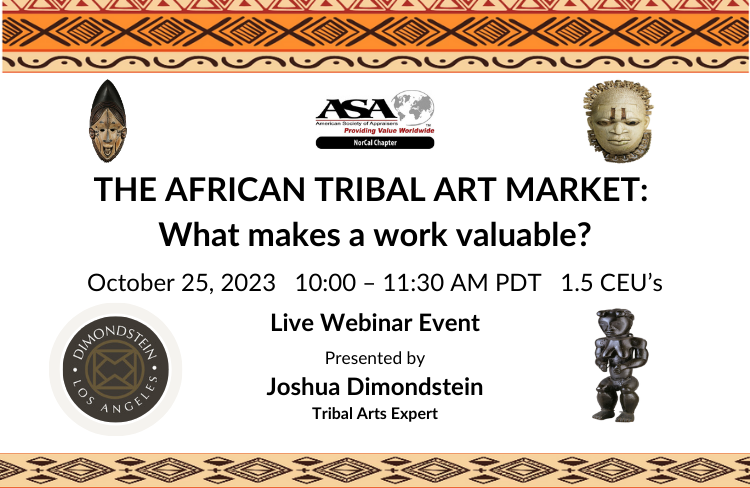REGISTER HERE
According to the New York Times, worldwide art and antiques sales reached an estimated $67.8 billion in 2022. Recorded sales of African tribal art during that year were estimated to be less than $50M, or less than a tenth of a percent of the estimated total. Within such a small worldwide market segment, exposure to the market forces that normally affect and regulate value—even those as basic as supply and demand–are not always at play. During transactions, there is frequently a lack of knowledge of the relevant facts.
This webinar will provide a fundamental understanding of the tribal art market; how it functions at its different market levels; and how both fakes (reproductions) and collectors’ misguided perceptions and expectations can affect an appraiser’s value conclusions.
ABOUT SPEAKER
Joshua Dimondstein, Candidate Member, ASA, has been a dealer, collector, consultant, and appraiser of tribal art since 1996. He serves as a consultant to Bonhams; is a contributing writer to the magazine “Tribal”; and is active in SFTribal and LATribal, two organizations that he helped cofound. He is also a member of ATADA (Authentic Tribal Arts Dealers Association), and a Candidate Member of ASA.
Always current on the market, Dimondstein is a regular exhibitor in tribal art shows in Brussels, Paris, San Francisco and Santa Fe. His total emersion in tribal art and the tribal art market, in addition to his involvement and continuing education in ASA, qualifies him as an appraiser and a lecturer about tribal art.More about Joshua Dimondstein can be found at Dimondstein Tribal Arts – San Francisco Tribal (sftribal.com)
Additional information
The African tribal art market level in which I operate wouldn’t be of particular interest to appraisers. It’s just like any other niche art market for the serious collector. And though it is the mainstream, it represents a very, very small percentage of the total number of African art objects that are sold yearly. It’s the “tribal art” sold at the lower market levels–the lion’s share of the total number of African art pieces that are bought and sold–that should be of interest to appraisers. This is where the rules are defied. Though the discussion will be in the context of the challenges faced by the appraiser when appraising tribal art that’s been sold at its lower market levels, it will provide an overview of a very interesting, quirky market

